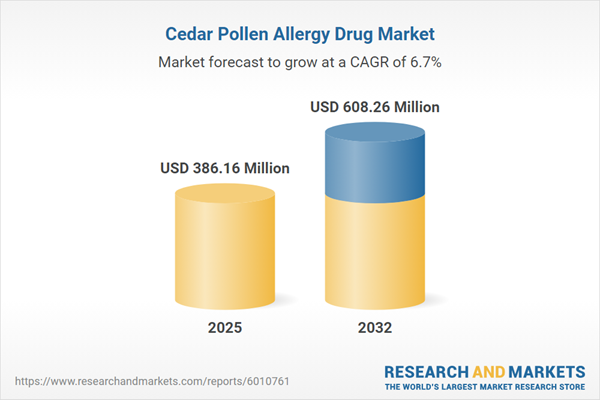Speak directly to the analyst to clarify any post sales queries you may have.
The cedar pollen allergy drug market is evolving swiftly, shaped by pharmaceutical innovation and a focus on patient-centered care. Strategic decisions made today will enable leaders to adapt to the changing supply environment and strengthen their positioning within this high-potential therapeutic area.
Market Snapshot: Cedar Pollen Allergy Drug Market Size and Growth Potential
The global cedar pollen allergy drug market is experiencing steady expansion, driven by rising public awareness regarding allergies and lifestyle shifts that enhance the need for new therapeutic interventions. Investment in research is fueling continued momentum, opening markets in both developed and emerging economies. The competitive landscape remains vibrant, with advances in technology propelling product development and drawing new entrants. These market drivers are contributing to long-term resilience, supporting robust investment in integrated patient care solutions and ensuring reliable growth opportunities.
Cedar Pollen Allergy Drug Market Scope & Segmentation
- Drug Type: Antihistamines target immediate symptom relief; combination therapies increase efficacy by addressing several mechanisms simultaneously; corticosteroids are selected to address long-term inflammatory processes; leukotriene receptor antagonists serve patients with complicated respiratory profiles.
- Route of Administration: Nasal sprays, eye drops, oral syrups, tablets, and ocular solutions permit flexibility in acute as well as maintenance regimens, aligning with various patient and clinical demands.
- Distribution Channel: Hospital pharmacies ensure access for urgent interventions, retail pharmacies enable ongoing management, and online platforms improve availability and patient-provider engagement worldwide.
- End User: Outpatient clinics, hospitals, and home-care settings are all served by the market, allowing therapy customization tailored to individual patient settings and routines.
- Patient Age Group: Formulations and dosing regimens are tailored to adults, children, and older adults, addressing unique pharmacological needs and supporting long-term adherence for each age group.
- Regional Coverage: The Americas, Europe, Middle East, Africa, and Asia-Pacific present distinct regulatory landscapes and infrastructure levels, prompting strategic adaptation and collaboration to ensure effective regional integration.
- Key Companies Profiled: Pfizer Japan Inc., Bayer Yakuhin Ltd., Shionogi & Co. Ltd., UCB Japan Co. Ltd., Sanofi K.K., Kyorin Pharmaceutical Co. Ltd., GlaxoSmithKline K.K., Merck Sharp & Dohme K.K., Kyowa Kirin Co. Ltd., and Eisai Co. Ltd. offer localized expertise and adapt solutions to fit dynamic market requirements.
Cedar Pollen Allergy Drug Market: Key Takeaways for Senior Decision-Makers
- Emerging immunotherapies, such as monoclonal antibody-based drugs, offer greater precision and more tailored interventions for specific patient segments.
- Integration of digital health solutions and telemedicine is transforming ongoing allergy management, facilitating remote symptom tracking and timely intervention.
- Strategic partnerships, cross-sector alliances, and mergers stimulate accelerated product development and streamline navigation of regulatory processes.
- Combining established regimens with the introduction of biologics encourages flexible treatment pathways that align with clinical and patient-specific requirements.
- Regional diversity in reimbursement, regulation, and payer expectations necessitates agile, market-specific planning for optimized growth and reliable access.
Tariff Impact on Cedar Pollen Allergy Drug Supply Chains
Changes in U.S. tariff policy have led to adjustments in sourcing and manufacturing practices, resulting in broader supply chain diversification and localized investment. Strengthened partnerships with payers now play a central role in defining competitive pricing and maximizing treatment accessibility, especially in an evolving market and regulatory environment.
Methodology & Data Sources
Market findings are compiled from interviews with senior pharmaceutical executives and consultations with specialists in clinical practice and supply chain management. Data are validated through literature reviews, commercial data repositories, region-specific analyses, and targeted surveys, delivering clear and actionable market intelligence.
Why This Report Matters
- Assists executive teams in realigning operations and strategies with the evolution of therapies and market trends in cedar pollen allergy drug development.
- Delivers guidance to improve regulatory adaptability and supply chain resilience in response to emerging distribution and access challenges.
- Empowers leaders with forward-looking analyses for informed planning as the market continues to shift and diversify.
Conclusion
This report helps senior decision-makers set clear objectives, enhance supply chain strategies, and advance standards of care to succeed in the evolving cedar pollen allergy drug sector.
Additional Product Information:
- Purchase of this report includes 1 year online access with quarterly updates.
- This report can be updated on request. Please contact our Customer Experience team using the Ask a Question widget on our website.
Table of Contents
3. Executive Summary
4. Market Overview
7. Cumulative Impact of Artificial Intelligence 2025
Companies Mentioned
The companies profiled in this Cedar Pollen Allergy Drug market report include:- Pfizer Japan Inc.
- Bayer Yakuhin, Ltd.
- Shionogi & Co., Ltd.
- UCB Japan Co., Ltd.
- Sanofi K.K.
- Kyorin Pharmaceutical Co., Ltd.
- GlaxoSmithKline K.K.
- Merck Sharp & Dohme K.K.
- Kyowa Kirin Co., Ltd.
- Eisai Co., Ltd.
Table Information
| Report Attribute | Details |
|---|---|
| No. of Pages | 194 |
| Published | October 2025 |
| Forecast Period | 2025 - 2032 |
| Estimated Market Value ( USD | $ 386.16 Million |
| Forecasted Market Value ( USD | $ 608.26 Million |
| Compound Annual Growth Rate | 6.6% |
| Regions Covered | Global |
| No. of Companies Mentioned | 11 |









